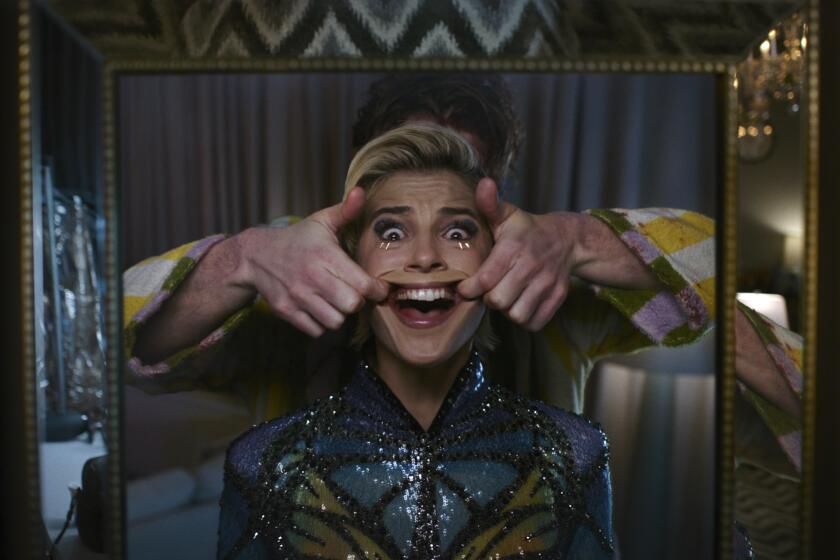Movie retreads on the skids
In recent years, everyone in the movie business has been scrambling to churn out sequels, remakes and retreads, justifying the unseemly artistic results by trumpeting the killing theyâve made at the box office. Well, if youâve been keeping tabs over the past six weeks, the scorecard reads: Moviegoers: 5. Risk-Averse Studios: 1.
If youâd put your ear to the door at almost any studio in town last week, you couldâve heard someone saying, âGeez, maybe getting audiences to spend $9.50 for a half-baked update of a (fill in the blank: TV spy show/â30s adventure movie/â60s thriller/â70s art-house classic) isnât such a slam-dunk after all.â
The muttering was especially loud at Sony Pictures, where the studioâs supposed sure thing âI Spyâ staggered into the theaters with a feeble $12-million opening weekend. âThe Four Feathers,â a lavish remake co-financed by Paramount and Miramax, did even worse, making $18 million in its brief stay in theaters. âSwept Away,â the Madonna-starring remake of Lina Wertmullerâs 1975 original, disappeared after making a paltry $598,000 in its short run. Jonathan Demmeâs âThe Truth About Charlie,â an update of Stanley Donenâs âCharade,â has stumbled badly, barely doing $4 million in its first two weeks. Even the $90-million âRed Dragon,â a third installment in the Hannibal Lecter series that was supposed to be Universalâs big moneymaker this year, has been such a lackluster performer that it probably wonât hit the $100-million mark, a steep drop-off from last yearâs $165-million-grossing âHannibalâ sequel.
The only retread to have a solid opening was Disneyâs âSanta Clause 2,â which has made about $60 million in its first two weeks. Even it will be hard-pressed to top the original, which made $144 million in 1994 and was so well-liked that it did better in its third weekend of release than its first.
The common denominator with nearly every failure was a woeful absence of originality, not to mention ambition. No matter how hard Hollywood tries to brainwash moviegoers into embracing familiarity, when we gather in the dark we crave something fresh and new. Maybe thatâs why films such as âThe Ring,â âMy Big Fat Greek Weddingâ and âBarbershopâ have found such surprisingly large, loyal audiences.
Making movies is never going to be a risk-free business. In recent years studio chieftains have extolled franchise movies the way 1999-era stock analysts used to puff up dot-com IPOs. Sequels were the showbiz equivalent of easy money, providing a soothing predictability to a notoriously topsy-turvy business. Even the vocabulary changed -- studio tycoons began talking about movies as if they were part of a stock portfolio. Asked last year about Warner Bros.â studio-wide efforts to launch dozens of different franchises, Chairman Barry Meyer enthused, âWeâre looking to extend these properties over multiple platformsâ -- now thereâs a phrase to get moviegoersâ hearts pumping.
But not every property has been a winner like âAustin Powersâ or âRush Hour.â Billed as this summerâs big kid hit, âStuart Little 2â was a crushing disappointment. âThe Scorpion King,â a much-touted spinoff of the âMummyâ series, did less than half the business of the âMummyâ sequel.
Studios are now making sequels out of films that didnât even make $60 million at the box office. âIt used to be that a film had to make $100 million to justify a sequel,â says industry box-office expert Paul Dergarabedian, president of Exhibitor Relations Inc.
âNow all a film has to do is have a big opening weekend. Sometimes people donât even look at the end results.â
âI Spyâ was viewed as a canât-miss hit, but now the industryâs Monday morning quarterbacks are searching for answers. Itâs deeply ingrained in Hollywood culture that there must be an explanation for every flop; no one likes to admit that audiences turned up their noses because the movie -- heaven forbid -- was unwatchable.
Most of the blame for âI Spyâsâ demise is being placed on the usual suspects: the marketing campaign, which was especially insipid even by major studio standards, and the stars, in particular Eddie Murphy, who has now headlined three consecutive bombs, with âI Spyâ following âPluto Nashâ and âShowtime.â Murphyâs casting offers a classic example of how clueless Hollywood can be. âI Spyâ was aimed at a young male audience, which looks at Murphy and sees ... Bill Cosby. The right star for the picture wouldâve been DMX or Ice Cube, hip-hop icons who have credibility with young male moviegoers. (Witness Eminem, whose film, â8 Mile,â had a huge opening this week- end.)
Co-star Owen Wilson gets off easier, though many view him as an actor whose quirky charm goes over in Hollywood and New York -- and almost nowhere in between.
âI Spyâ turned out to be an old TV title, like Will Smithâs âWild Wild West,â which had no resonance with anyone under 40. Even its premise felt dated. There have been so many seismic changes in Americaâs youth culture over the past few years that the whole âI Spyâ hook -- teaming a black hipster with a repressed white guy -- has a been-there-seen-that vibe with young moviegoers.
Talk about being behind the curve: Hollywood has become relentlessly brand-conscious at precisely the time when Madison Avenue has discovered that young consumers have less brand loyalty than ever before. Exploiting a brand is fine if youâre promoting family fare like âHarry Potterâ or âShrekâ (parents live for the arrival of a reassuring brand), but it carries increasingly less weight with teens.
Todayâs most effective advertising sells attitude, not brand. If movie execs want a scary lesson in diminished brand loyalty, just look at the music business, where fans have become totally song-oriented, leaving artists in the lurch. Alanis Morissetteâs âJagged Little Pillâ sold 14.1 million copies; her follow-up album sold 2.5 million copies. Lauren Hillâs âMiseducationâ CD sold 6.2 million copies; her follow-up CD, released earlier this year, has sold only 432,000 copies.
This audience capriciousness has already seeped into the movies: Just ask the makers of âScary Movie,â whose sure-thing sequel did barely 40% the business of the original.
That doesnât mean sequels are inherent evils: I wouldnât miss âThe Matrix Reloadedâ or âLord of the Rings: The Two Towersâ or âX-Men 2,â and Iâm looking forward to seeing what David Fincher can do with the âMission Impossibleâ franchise and Alfonso Cuaron does with the third âHarry Potter.â But those films are in the hands of filmmakers who thrive on risk and daring. My hopes arenât as high for âScooby-Doo 2.â
*
(BEGIN TEXT OF INFOBOX)
The second time around
Hereâs a look at a few upcoming sequels Iâm betting have especially questionable commercial prospects.
âTomb Raider 2â
The original made $131 million last year, but the number that counts is 59%, which is the amount the film dropped in its second weekend of business, a sign of deep dissatisfaction. More worrisome, the filmâs star, Angelina Jolie, is no longer the industryâs It Girl. Her fan base has moved on to other female stars, and her last two vehicles, âLife or Something Like Itâ and âOriginal Sin,â were bombs. The sequel, due next summer, is being directed by Jan De Bont, who is many things but not a career rejuvenator.
âFinal Destination 2â
New Line has lots of valuable franchises, but this isnât one of them. The original was a low-budget surprise, doing $53 million in 2000. But the sequel, due next year, has a no-name cast and a first-time director who is best known as a second-unit director. The sequel is being positioned as a date-night thriller, but itâll need a great trailer and release date to make you believe this will work any better than âTown and Country 2.â
âJeepers Creepers 2â
The original, a low-budget MGM horror flick, made $37.5 million, but it opened on Labor Day, the least-competitive weekend of the year. The sequel, due in April, will be up against stiffer competition. âScreamâ was a real franchise. Jeepers, shouldnât this be a direct-to-video sequel?
âShanghai Knightsâ
The original, âShanghai Noon,â which teamed Jackie Chan with Owen Wilson, only did $57 million here (and even less overseas), despite the presence of Chan, who supposedly has a big international fan base. The sequel, due next year, will be a true test of whether Wilson can connect with a mainstream audience.
âTerminator 3: Rise of the Machinesâ
Due out July 4, 2003, this movie cost about $150 million, which is more than the total domestic gross of Arnold Schwarzeneggerâs last three features together. Without âTerminatorâ creator James Cameron or a young name-actor on board, this looks like a huge financial risk. Warners paid $50 million for the domestic distribution rights, but the studio still has to persuade me that seeing Arnold battle a bunch of bad guys would be as interesting as watching him run for governor of California.
*
The Big Pictureâ runs each Tuesday in Calendar. If you have questions, ideas or criticism, e-mail them to [email protected].
More to Read
Only good movies
Get the Indie Focus newsletter, Mark Olsen's weekly guide to the world of cinema.
You may occasionally receive promotional content from the Los Angeles Times.










